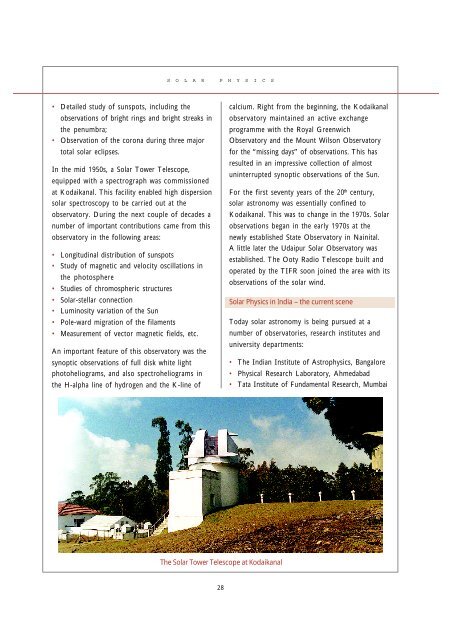2004 ASTRONOMY & ASTROPHYSICS - Indian Academy of Sciences
2004 ASTRONOMY & ASTROPHYSICS - Indian Academy of Sciences
2004 ASTRONOMY & ASTROPHYSICS - Indian Academy of Sciences
You also want an ePaper? Increase the reach of your titles
YUMPU automatically turns print PDFs into web optimized ePapers that Google loves.
SOLAR PHYSICS<br />
• Detailed study <strong>of</strong> sunspots, including the<br />
observations <strong>of</strong> bright rings and bright streaks in<br />
the penumbra;<br />
• Observation <strong>of</strong> the corona during three major<br />
total solar eclipses.<br />
In the mid 1950s, a Solar Tower Telescope,<br />
equipped with a spectrograph was commissioned<br />
at Kodaikanal. This facility enabled high dispersion<br />
solar spectroscopy to be carried out at the<br />
observatory. During the next couple <strong>of</strong> decades a<br />
number <strong>of</strong> important contributions came from this<br />
observatory in the following areas:<br />
• Longitudinal distribution <strong>of</strong> sunspots<br />
• Study <strong>of</strong> magnetic and velocity oscillations in<br />
the photosphere<br />
• Studies <strong>of</strong> chromospheric structures<br />
• Solar-stellar connection<br />
• Luminosity variation <strong>of</strong> the Sun<br />
• Pole-ward migration <strong>of</strong> the filaments<br />
• Measurement <strong>of</strong> vector magnetic fields, etc.<br />
An important feature <strong>of</strong> this observatory was the<br />
synoptic observations <strong>of</strong> full disk white light<br />
photoheliograms, and also spectroheliograms in<br />
the H-alpha line <strong>of</strong> hydrogen and the K-line <strong>of</strong><br />
calcium. Right from the beginning, the Kodaikanal<br />
observatory maintained an active exchange<br />
programme with the Royal Greenwich<br />
Observatory and the Mount Wilson Observatory<br />
for the “missing days” <strong>of</strong> observations. This has<br />
resulted in an impressive collection <strong>of</strong> almost<br />
uninterrupted synoptic observations <strong>of</strong> the Sun.<br />
For the first seventy years <strong>of</strong> the 20 th century,<br />
solar astronomy was essentially confined to<br />
Kodaikanal. This was to change in the 1970s. Solar<br />
observations began in the early 1970s at the<br />
newly established State Observatory in Nainital.<br />
A little later the Udaipur Solar Observatory was<br />
established. The Ooty Radio Telescope built and<br />
operated by the TIFR soon joined the area with its<br />
observations <strong>of</strong> the solar wind.<br />
Solar Physics in India – the current scene<br />
Today solar astronomy is being pursued at a<br />
number <strong>of</strong> observatories, research institutes and<br />
university departments:<br />
• The <strong>Indian</strong> Institute <strong>of</strong> Astrophysics, Bangalore<br />
• Physical Research Laboratory, Ahmedabad<br />
• Tata Institute <strong>of</strong> Fundamental Research, Mumbai<br />
The Solar Tower Telescope at Kodaikanal<br />
28
















